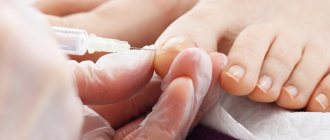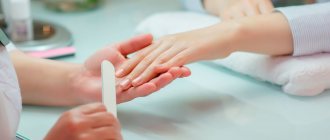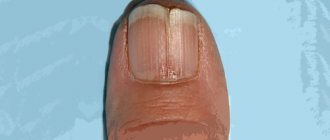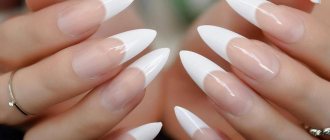Hallux valgus is a disease in which the metatarsophalangeal joint of the big toe becomes bent, followed by the formation of a “bump” at its base. This condition is popularly known as “thumb bone.”
It is important to understand that a protruding bone is not just a cosmetic defect. This is a full-fledged disease that requires specialized treatment. In its absence, there is a risk of developing bursitis and curvature of other toes.
What is an ingrown toenail?
With this disease, the nail plate grows into the periungual fold. The big toe is most often affected. The disease begins with some “provoking” moment - an injury during a pedicure, a bruise, wearing tight shoes, etc. Swelling of the roller occurs, it is pressed more tightly against the nail plate and is slightly injured by it (an abrasion, a microcrack occurs). This, in turn, causes increased swelling and pain. Almost immediately an infection sets in - microorganisms invade the wound. Inflammatory phenomena gradually progress - redness appears in the area of the periungual fold, pain and swelling increase. Pus begins to secrete between the nail and the roller, and later hypergranulations appear there (the so-called “wild meat”). Before infection sets in, ingrown toenails can still be stopped by treatment at home - it will be described below. When suppuration occurs, and especially when “wild meat” appears, conservative treatment is always ineffective; it can only bring a short-term reduction in symptoms. Only surgical intervention can radically help.
Kinds
Manifestations of hyperkeratosis form on the legs, arms, torso, scalp, palms, and feet. Their location and appearance depend on the reasons for their appearance.
The most common types of thickenings are:
- Calluses, corns on the soles of the feet and palms. Formed in areas subject to prolonged friction or pressure;
- Actinic keratosis. Develops due to excessive exposure of the skin to ultraviolet rays. Appears as flat, rough patches of yellow, brown or red color;
- Follicular hyperkeratosis (“goose bumps”). This is a rash of small multiple tubercles on the face, shoulders, legs, and buttocks. It is caused by a violation of the exfoliation of dead skin particles. This form of hyperkeratosis occurs in children; it goes away on its own in adolescence;
- Warts. Occurs when infected with the human papillomavirus. They appear as convex growths of various shapes and sizes. On the feet they are called plantar warts;
- Under nail hyperkeratosis. This is a thickening of the skin in the area of the nail bed, nail folds, which is caused by injuries, psoriasis, and onychomycosis. It leads to lifting, bending, and deformation of the nail plate.
You can see what different types of hyperkeratosis look like in the photo on the Internet. Its manifestations also include skin changes in certain skin diseases - eczema, psoriasis, lichen planus, seborrhea.
Causes of ingrowth - why does it happen
Most often, an ingrown toenail (synonymous with onychocryptosis) is the result of a combination of several causes.
- Trauma - can be caused by a pedicure (even an unsuccessful tearing off of a small hangnail can cause swelling of the roller, and this will provoke an ingrowth), direct trauma (blow, bruise).
- Wearing tight, uncomfortable shoes, especially with a narrow “toe” and high heels.
- A large (congenital) periungual ridge is one of the serious causes, which, despite numerous operations, can cause repeated ingrowths (relapses). Plastic surgery of the periungual fold helps solve the problem - it will be described below.
- Flat feet - when the first toe deviates outward, there is excess pressure on the cushion from the side of the second toe.
- Pregnancy and the postpartum period - according to statistics, the likelihood of ingrowth increases during this time, apparently, this is due to a temporary change in posture and foot settings.
- Fungal infections of the nails deform the nail and increase the risk of disease.
The direct cause of an ingrown toenail can be either one of the predisposing factors or a combination of them.
Women over 30 years of age most often come to our Clinic with this problem. Main reasons:
- heredity
- wearing uncomfortable shoes
- excessive physical activity
- overweight
- hormonal changes (including after pregnancy)
- inflammatory processes in the joints
- consequences of injuries or unsuccessful surgical interventions.
At first, protruding bones seem to be a cosmetic defect; over time, pain appears, the motor ability of the foot is impaired, and as a result, arthrosis of the knee and hip joint, osteochondrosis and other pathologies associated with the musculoskeletal system develop. Depending on the severity of the deformity, various surgical techniques are used for treatment. At the initial stages of deformation, treatment must begin with conservative methods.
Establishing diagnosis
Before prescribing treatment, our specialists conduct a thorough diagnosis of the patient; during this diagnosis, the etiology (origin of the disease) and severity are identified. There are international standards by which all orthopedic traumatologists classify pathology according to the same principles, namely:
- Static.
The deformation occurred due to poor posture - Congenital.
The disorder is associated with a genetic feature of the position of one of the bones of the foot - Compensatory.
In this case, the deformation is a response to the anatomical feature of the tendon, as a result of which the tibia changes position and deforms the ankle joint; - Paralytic deformity.
Occurs after polio or other inflammatory processes in the central nervous system; - Spastic
. It is a complication of muscle spasms; - Hypercorrectional.
In case of improper treatment of foot pathologies; - Traumatic.
It is a complication of fractures and ligament injuries.
The significance of this classification is that treatment of pathology is impossible without addressing the cause. The operation will relieve the patient of deformity and lead to a normal lifestyle. And influencing the etiology of the disease will help avoid the reappearance of deformity.
Depending on the severity, hallux valgus deformity can be:
- Easy
- Average
- Heavy
The method of treating the patient depends on the severity of the disease.
Symptoms
Diagnosing an ingrown toenail is usually not difficult. The main symptom is pain in the area of the periungual fold, first with pressure, and then at rest. Swelling and redness quickly develop. Pus soon begins to appear between the roller and the nail. Redness increases, and with the use of various remedies it may temporarily decrease, but almost always the process becomes chronic and can last for months. Chronicity of the disease is characterized by the appearance of hypergranulations (“wild meat”). In very rare and advanced cases, inflammation can spread to the phalanx bone - osteomyelitis.
There are usually no changes in the patient's general condition. In a blood test, there may be a slight increase in the number of leukocytes during acute inflammation and an increase in ESR. With prolonged ingrowth, it is necessary to perform an x-ray of the finger to exclude involvement of the phalanx bone in the process - osteomyelitis.
Stages of hallux valgus deformity of the big toe
Traumatologists and orthopedists at the Komarova Clinic identify several stages of deformation:
- First stage: displacement no more than 20 degrees. There are no unpleasant sensations, only aesthetic inconvenience.
- Second stage: displacement of 20-30 degrees. When walking for a long time, pain appears.
- Third stage: displacement of 30-50 degrees. The bunion prevents you from walking, it hurts, and it becomes difficult to find comfortable shoes.
- Stage four: displacement greater than 50 degrees. Constant pain and ongoing inflammation bring suffering even at rest. The deformity begins to affect other phalanges of the fingers.
Treatment methods
Treatment of an ingrown toenail is carried out using different methods. The main and most reliable method is surgery. Thumb surgery is performed on an outpatient basis and does not require hospitalization. There are several modifications of operations, incl. using radio waves and lasers. The doctor decides which operation to perform on a given patient, depending on the specific situation.
Anesthesia for operations on ingrown toenails is always conductive - a small amount of anesthetic is injected into the base of the finger on both sides under the skin, after which you need to wait 5 - 10 minutes, and the finger will be completely anesthetized. With this type of anesthesia, the operation is completely painless in 100% of cases.
Let's consider the main types of operations. They all solve the problem of how to remove an ingrown toenail.
Regional resection of the nail plate using radio waves or lasers.
This method is the most common, low-traumatic and reliable; it involves removing the ingrown edge of the nail (1–2 mm), treating a fragment of the growth zone with a radio wave or laser, and removing purulent tissue along the edge of the periungual fold. It should be noted that there is no fundamental difference between radio wave and laser exposure; both of these devices ensure reliable destruction of the desired fragment of the growth zone with minimal damage to neighboring tissues.
Baths and compresses
Traditional medicine recipes can help here too. Remember that any disease requires mandatory consultation with a specialist, and traditional methods play only a supporting role. However, they can help with fungus and thick toenails. The treatment is gentle and comfortable.
There are several recipes for softening nails:
- Kombucha compress. You should take one mushroom out of the jar, cut it into several small pieces and apply it to the rough areas. The compress is wrapped in a bag on top, socks are put on and worn for 8-10 hours. After this, it will be more convenient to file or trim your nails.
- Compress with aloe leaves. Select a small juicy aloe leaf, wash and cut it into pieces and apply the pulp to problem areas. It is convenient to fix the leaves on top with adhesive tape. Typically, such a compress is worn at night and removed in the morning.
- Soda bath. 3 tbsp. Mix soda with a third of a piece of tar soap and steam your feet for 20 minutes.
- Bath with chamomile. Brew a glass of chamomile flowers in 2 liters of boiling water, strain and boil. Pour the resulting broth into a basin, cool slightly and lower your feet into it for 20 minutes. This bath will disinfect and soothe tired feet. Suitable as a remedy to soften a nail with fungus.
- Apple cider vinegar compress. Cotton pads are soaked in 9% apple cider vinegar and glued to problem nails. Wrap the top with cling film for warmth and put on socks. After 2 hours, remove the compress, rinse your feet with clean water and apply cream.
- A bath based on potassium permanganate. Several crystals are dissolved in warm water, the sediment is removed and diluted to a light pink hue. A warm solution is used to steam, disinfect and soften toenails.
- Hydrogen peroxide. Helps in the treatment of nail and foot fungus, softens rough skin. Add 5 tbsp to a couple of liters of boiling water. peroxide and steam the feet in the solution for a maximum of 15 minutes. After the procedure, it is recommended to lubricate your feet with a nourishing cream.
- Vinegar bath. Dilute 250 ml of vinegar into 2 liters of water and steam your feet for 10-15 minutes.
Marginal resection of the nail plate with plastic surgery of the periungual fold according to Schmieden
The method is clearly indicated for patients with excess periungual ridge. If you leave such a roller, then in all other types of operations it will still be the cause of relapse. A relative indication is multiple relapses after other interventions.
Surgery technique: a conventional marginal resection is performed using radio waves or a laser, which is supplemented by a wedge-shaped excision of the periungual fold with closure of the defect with sutures. The sutures are removed on days 7–8, after which recovery begins. Relapses after Schmiden's surgery are extremely rare.
Self-treatment at home and folk remedies
Such treatment is permissible only in the very initial manifestations of ingrowth, when there is only slight pain and swelling of the cushion. When suppuration occurs, and even more so when “wild meat” appears, treatment at home is ineffective; it may bring temporary relief, but all symptoms will soon return. In these cases, surgery is needed.
Among the “home” methods, we can recommend semi-alcohol dressings with Levomekol ointment. A strip of levomekol ointment is applied to the area of inflammation, after which the finger is wrapped in a gauze cloth soaked in vodka and secured with a regular bandage. The time to wear the bandage is until it dries completely. Can be applied twice a day - morning and night. If the symptoms do not disappear within 2-3 days, you need to consult a doctor who will determine how to properly treat this condition.
You should be warned against using methods such as the use of aloe and celandine. These drugs, like many similar ones, can cause severe local irritation of tissues, and thereby cause the progression of inflammation. In addition, an allergic reaction is possible. Vishnevsky ointment creates favorable conditions for the development of microflora, therefore it is also not recommended for use.
Practice shows that most often, after prolonged use of various “home” and “folk” methods, patients still end up undergoing surgery, but in a more “advanced” state.
Conservative treatment methods
They are mainly used for uncomplicated ingrown toenails, when there is no pronounced suppuration or persistent invasion of the nail plate into the tissue of the periungual fold. There are many known methods of conservative treatment - tamponade, application of corrective devices (plastic, metal, glued to the nail, in the form of one- and two-sided staples, etc.). In many cases, treatment with all these methods is quite effective. There are also disadvantages. The main ones include the following:
- Duration of treatment – correction of a nail with staples takes weeks and sometimes months, but the result is not 100% guaranteed, and it is possible that in the end you will still need surgery to remove the ingrown nail.
- High price. The corrective devices themselves are not very expensive, but they need to be constantly monitored, which requires repeated visits to a specialist, and, in total, is not cheap.
- The presence and visibility of a brace on the leg (and it needs to be worn for quite a long time and can only be removed at the end of the course of treatment).
- A good effect can be achieved only if the treatment is carried out by an experienced podologist; there are few such specialists, although many undertake to treat with these methods, often without proper knowledge of the technique.
Prevention methods
To prevent ingrown toenails, you need to follow several rules, which in most cases help to avoid problems.
Firstly, you need to wear comfortable shoes not with narrow toes, the heel should be no more than 4 cm high.
Secondly, it is necessary to trim the nail correctly - the edge of the nail must “come out” of the roller, and only then can it be rounded. Thus, the pressure on the roller will be not from the “angle”, but from the “plane”, which will reduce the likelihood of ingrowth.
Thirdly, if you have flat feet, you need to wear special orthopedic insoles.
Fourthly, if you have nail fungus, it needs to be treated by a dermatologist or mycologist.
Methods of surgical correction of thumb deformity in Vladivostok
However, today the most effective treatment for bunions on the leg is surgical correction.
There are many surgical techniques to return the finger to its normal position. “Reconstruction” of a hallux valgus in our clinic is carried out using the most modern methods. These techniques allow patients to return to their normal lives as quickly as possible. For the first time after surgery, it is necessary to wear special shoes that do not place stress on the forefoot. Then you can switch to orthopedic shoes, or move with the help of crutches or a stick. It is important to understand that the operation eliminates only a cosmetic defect (that is, the “bump” itself), but does not restore the transverse arch of the foot. To prevent the bunion from appearing again, you will have to wear only the right shoes with arch support and custom orthopedic insoles for the rest of your life.
Where to delete?
To solve the problem, you need to contact a surgeon. Only this specialist can get rid of an ingrown toenail. When choosing a specialist, you need to be guided by his experience and work experience. It will be useful to read reviews about it from other patients (they can always be found on the Internet). A large number of negative reviews, as well as the lack of reviews, should alert you. The clinic where the doctor works must have the necessary equipment for radio wave or laser removal. The doctor must have sufficient experience working with these devices, because with insufficient exposure to radio waves or lasers, a relapse may occur, and with excessive exposure, damage to adjacent areas of the growth zone may occur, which will cause permanent deformation of the entire nail. The surgeon must also be able to perform plastic surgery of the periungual fold in order to apply this method if there are appropriate indications.
Dr. Elshansky Igor Vitalievich has worked as a surgeon since 1993, candidate of medical sciences, has been treating ingrown toenails for more than 20 years, knows all treatment methods and modifications of operations. The clinic has a radio wave device; there are all conditions for diagnosing and treating ingrown toenails at any stage of the disease.
All our videos on ingrown toenails - https://www.youtube.com/playlist?list=PLP8p3HIB4FTJprjiZKvJ6e_oY2pcnHL6u











